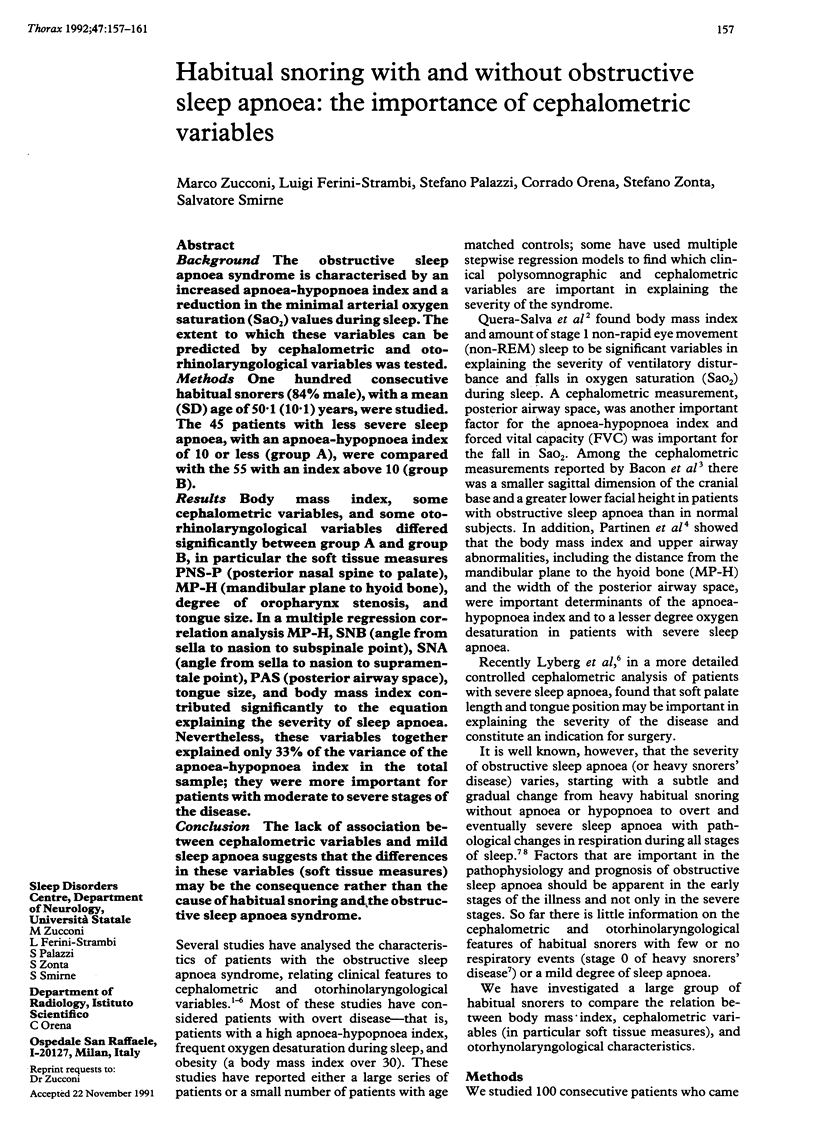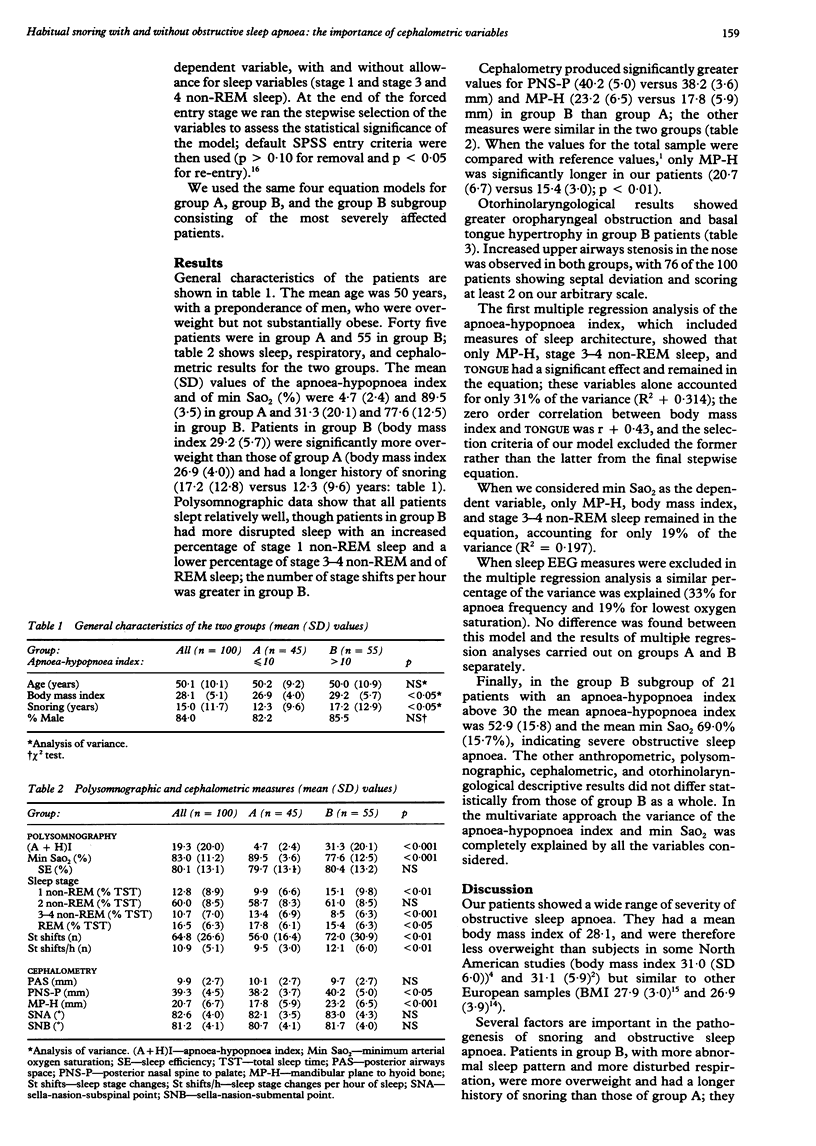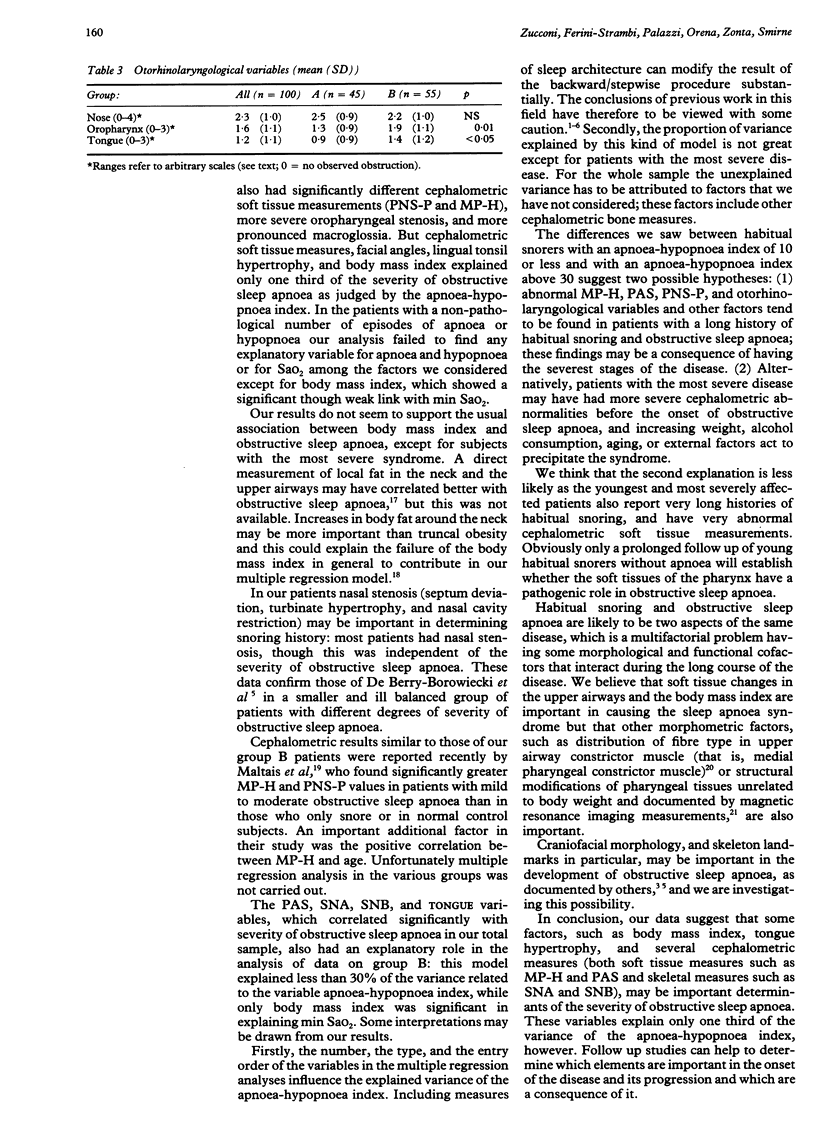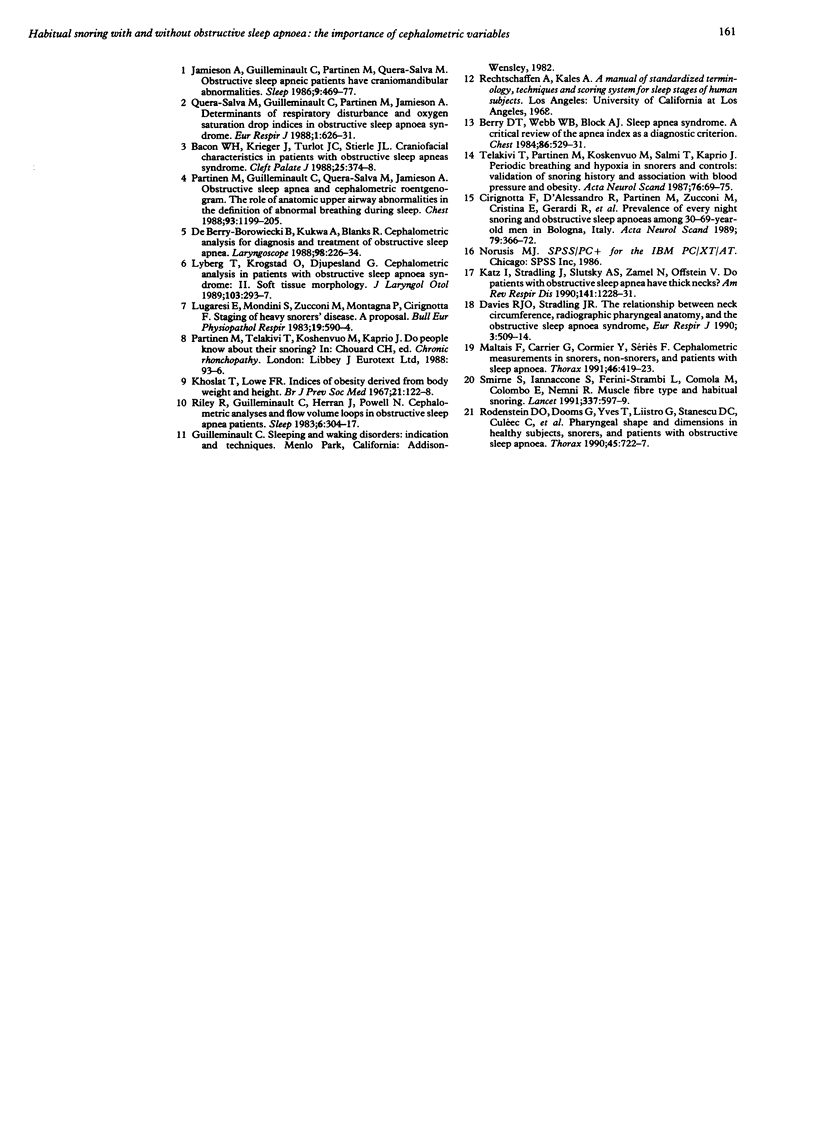Abstract
BACKGROUND: The obstructive sleep apnoea syndrome is characterised by an increased apnoea-hypopnoea index and a reduction in the minimal arterial oxygen saturation (SaO2) values during sleep. The extent to which these variables can be predicted by cephalometric and otorhinolaryngological variables was tested. METHODS: One hundred consecutive habitual snorers (84% male), with a mean (SD) age of 50.1 (10.1) years, were studied. The 45 patients with less severe sleep apnoea, with an apnoea-hypopnoea index of 10 or less (group A), were compared with the 55 with an index above 10 (group B). RESULTS: Body mass index, some cephalometric variables, and some otorhinolaryngological variables differed significantly between group A and group B, in particular the soft tissue measures PNS-P (posterior nasal spine to palate), MP-H (mandibular plane to hyoid bone), degree of oropharynx stenosis, and tongue size. In a multiple regression correlation analysis MP-H, SNB (angle from sella to nasion to subspinale point), SNA (angle from sella to nasion to supramentale point), PAS (posterior airway space), tongue size, and body mass index contributed significantly to the equation explaining the severity of sleep apnoea. Nevertheless, these variables together explained only 33% of the variance of the apnoea-hypopnoea index in the total sample; they were more important for patients with moderate to severe stages of the disease. CONCLUSION: The lack of association between cephalometric variables and mild sleep apnoea suggests that the differences in these variables (soft tissue measures) may be the consequence rather than the cause of habitual snoring and the obstructive sleep apnoea syndrome.
Full text
PDF




Selected References
These references are in PubMed. This may not be the complete list of references from this article.
- Bacon W. H., Krieger J., Turlot J. C., Stierle J. L. Craniofacial characteristics in patients with obstructive sleep apneas syndrome. Cleft Palate J. 1988 Oct;25(4):374–378. [PubMed] [Google Scholar]
- Berry D. T., Webb W. B., Block A. J. Sleep apnea syndrome. A critical review of the apnea index as a diagnostic criterion. Chest. 1984 Oct;86(4):529–531. doi: 10.1378/chest.86.4.529. [DOI] [PubMed] [Google Scholar]
- Cirignotta F., D'Alessandro R., Partinen M., Zucconi M., Cristina E., Gerardi R., Cacciatore F. M., Lugaresi E. Prevalence of every night snoring and obstructive sleep apnoeas among 30-69-year-old men in Bologna, Italy. Acta Neurol Scand. 1989 May;79(5):366–372. doi: 10.1111/j.1600-0404.1989.tb03802.x. [DOI] [PubMed] [Google Scholar]
- Davies R. J., Stradling J. R. The relationship between neck circumference, radiographic pharyngeal anatomy, and the obstructive sleep apnoea syndrome. Eur Respir J. 1990 May;3(5):509–514. [PubMed] [Google Scholar]
- Jamieson A., Guilleminault C., Partinen M., Quera-Salva M. A. Obstructive sleep apneic patients have craniomandibular abnormalities. Sleep. 1986 Dec;9(4):469–477. doi: 10.1093/sleep/9.4.469. [DOI] [PubMed] [Google Scholar]
- Katz I., Stradling J., Slutsky A. S., Zamel N., Hoffstein V. Do patients with obstructive sleep apnea have thick necks? Am Rev Respir Dis. 1990 May;141(5 Pt 1):1228–1231. doi: 10.1164/ajrccm/141.5_Pt_1.1228. [DOI] [PubMed] [Google Scholar]
- Khosla T., Lowe C. R. Indices of obesity derived from body weight and height. Br J Prev Soc Med. 1967 Jul;21(3):122–128. doi: 10.1136/jech.21.3.122. [DOI] [PMC free article] [PubMed] [Google Scholar]
- Lugaresi E., Mondini S., Zucconi M., Montagna P., Cirignotta F. Staging of heavy snorers' disease. A proposal. Bull Eur Physiopathol Respir. 1983 Nov-Dec;19(6):590–594. [PubMed] [Google Scholar]
- Lyberg T., Krogstad O., Djupesland G. Cephalometric analysis in patients with obstructive sleep apnoea syndrome: II. Soft tissue morphology. J Laryngol Otol. 1989 Mar;103(3):293–297. doi: 10.1017/s0022215100108746. [DOI] [PubMed] [Google Scholar]
- Maltais F., Carrier G., Cormier Y., Sériès F. Cephalometric measurements in snorers, non-snorers, and patients with sleep apnoea. Thorax. 1991 Jun;46(6):419–423. doi: 10.1136/thx.46.6.419. [DOI] [PMC free article] [PubMed] [Google Scholar]
- Quera-Salva M. A., Guilleminault C., Partinen M., Jamieson A. Determinants of respiratory disturbance and oxygen saturation drop indices in obstructive sleep apnoea syndrome. Eur Respir J. 1988 Jul;1(7):626–631. [PubMed] [Google Scholar]
- Rodenstein D. O., Dooms G., Thomas Y., Liistro G., Stanescu D. C., Culée C., Aubert-Tulkens G. Pharyngeal shape and dimensions in healthy subjects, snorers, and patients with obstructive sleep apnoea. Thorax. 1990 Oct;45(10):722–727. doi: 10.1136/thx.45.10.722. [DOI] [PMC free article] [PubMed] [Google Scholar]
- Smirne S., Iannaccone S., Ferini-Strambi L., Comola M., Colombo E., Nemni R. Muscle fibre type and habitual snoring. Lancet. 1991 Mar 9;337(8741):597–599. doi: 10.1016/0140-6736(91)91651-a. [DOI] [PubMed] [Google Scholar]
- Telakivi T., Partinen M., Koskenvuo M., Salmi T., Kaprio J. Periodic breathing and hypoxia in snorers and controls: validation of snoring history and association with blood pressure and obesity. Acta Neurol Scand. 1987 Jul;76(1):69–75. doi: 10.1111/j.1600-0404.1987.tb03547.x. [DOI] [PubMed] [Google Scholar]
- deBerry-Borowiecki B., Kukwa A., Blanks R. H. Cephalometric analysis for diagnosis and treatment of obstructive sleep apnea. Laryngoscope. 1988 Feb;98(2):226–234. doi: 10.1288/00005537-198802000-00021. [DOI] [PubMed] [Google Scholar]


